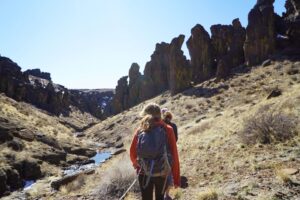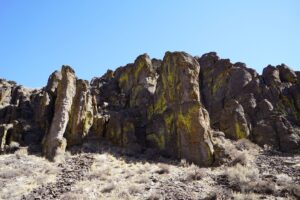From the powerful waterfalls of the Snake River to the iridescent springs that burst from the canyon walls, geologic wonders can be found across the Magic Valley. The valley’s dynamic geologic history, forged by volcanic flows, powerful floods, and relentless erosional processes, provides a vast variety of beautiful scenery and opportunities for outdoor recreation and adventure. Experiencing the wild parcels of Idaho’s high desert found in the Snake River Plain helps us to appreciate the importance of this landscape for Idaho’s environment, economy, and heritage.
Exploring the “Little City”
Spring is emerging in the Magic Valley and a great spot to immerse yourself in the season’s unfolding is the Little City of Rocks (not to be confused with the City of Rocks National Reserve near Almo). The Little City of Rocks, located in the Bennett Hills a few miles north of Gooding, is a Wilderness Study Area (WSA) managed by the Bureau of Land Management (BLM). A small group of Idaho Conservation League staff explored this aptly named landscape on a sunny day in early March, when the trails were mostly dry but snow lingered in the wintry shadows of the canyon.

Off Highway 46, we rendezvoused at a parking area on the dirt road a short walk from the trailhead into the Little City of Rocks. In spring when the road is muddy, the landowners who manage access to the trailhead close the road to vehicles. Respecting this closure, we began our journey down the dirt road until we reached an entry point through a manmade, medieval-esque rock wall. Once on the trail, the towering spires of the Little City’s hoodoo features beckoned us deeper into the landscape. The trail was easy to follow as it wound through the canyon along the creek.
This dramatic landscape is a story told in stone. Roughly 8 million years ago, what is now known as the Yellowstone hotspot was situated in the vicinity of present-day Twin Falls. This hotspot produced very explosive volcanic eruptions that generated substantial pyroclastic flows — dense, destructive masses of very hot ash, lava fragments, and gases that flow downslope at high speeds. These flows deposited thick ash layers in the Little City of Rocks area that remelted before solidifying as a volcanic rock called rhyolite. Contraction during cooling of this rock caused large fractures to develop, which allowed millennia of freeze-thaw cycles to weather the rock into the spectacular spires we see today.
The most striking rock spires are found in the first quarter mile of the trail, complete with eroded archways and balanced rocks. The canyon walls are covered in green mosses and multicolored lichens, a lush contrast to the muted tones of the dusty desert sky and spring sagebrush. At one point about 20 minutes into the hike, we came to a fork on the trail and opted to venture to the right, though the left fork led to another promising canyon with a trail.
We ambled up the main trail for about an hour and a half, catching glimpses of birds high in the canyon and other creatures scurrying into the shadows at the sound of our voices. Though some trail reports noted a possible lollipop loop, each bend on the trail revealed another stretch of canyon rather than a return route. So, after a sunny lunch on a rock bench that teased us with the summer weather ahead, we followed the creek back down to the fork and beyond to the trailhead. Near the end of our hike, the hooting of an owl stopped us dead in our tracks and we paused for a long moment to eavesdrop on the avian conversations that echoed overhead.
 The trail provides ample adventures readily accessible to beginners, with plenty of opportunity for exploring side canyons, outcroppings of rock features (and even petroglyphs), and sagebrush hillsides. One highlight was a series of trickling waterfalls, which started several hundred feet from the fork, that carved a deep notch into the canyon. We were able to easily scramble down to the water and enjoy the close-up view of the rushing creek.
The trail provides ample adventures readily accessible to beginners, with plenty of opportunity for exploring side canyons, outcroppings of rock features (and even petroglyphs), and sagebrush hillsides. One highlight was a series of trickling waterfalls, which started several hundred feet from the fork, that carved a deep notch into the canyon. We were able to easily scramble down to the water and enjoy the close-up view of the rushing creek.
Springtime is the perfect time to visit the Little City of Rocks, but be sure to respect the private lands at the access point by not driving on the dirt road when it is muddy. Give the area a day or two to dry out after spring rains. As always, practice Leave No Trace recreation and common sense, as the area is outside of cell service, contains rough terrain off the main trail, and serves as a habitat for a variety of wildlife, including rattlesnakes.
Protecting the Snake River and aquifer
The trickling waters that run through the canyons of the Little City of Rocks eventually flow into Idaho’s Snake River, the vital waterway that supports southern Idaho’s economy, well-being, and quality of life. A clean and safe Snake River is key to a healthy and prosperous future for southern Idaho and the harmful trend of declining water quality affects everyone who relies on it. Unfortunately, the Snake River and its aquifer are polluted by agricultural runoff, dairy waste, and discharge from fish farms. These pollutants, primarily phosphorus and nitrate, threaten water quality across southern Idaho, creating problems for the river’s ecosystem and endangering the health of more than 300,000 Idahoans who rely on the aquifer for drinking water.
Exploring special places like the Little City of Rocks and enjoying the spring runoff that splashes over the area’s waterfalls inspires us to work towards a future where all Idahoans have access to clean water. ICL is working on a campaign to clean up the Snake River across southern Idaho and restore water quality to safe and healthy levels. But to ensure that the Snake River is a safe place to swim, fish, and recreate, the river requires a bold effort to address the worsening problems from agricultural pollution. Congressman Mike Simpson’s “Northwest in Transition” proposal would invest $1.2 billion specifically for watershed restoration efforts in the Snake River Basin, including in southern Idaho. This proposed investment to improve water quality in the Snake is exactly what the watershed needs in order to address the long-standing pollution issues that threaten southern Idaho’s public health, environment, and prosperous future.
![]()
Take Action! Use your voice to tell Idaho’s decision-makers to support Rep. Simpson’s proposal and work towards restoring the Snake River.
Plan your own adventure to the Little City of Rocks!

